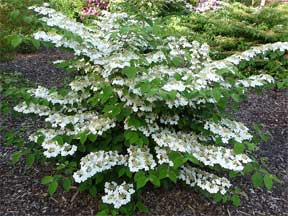OCTOBER: MONTH TO DIVIDE & MOVE PERENNIALS
Plant Pansies. Add slow release fertilizer. Remember to use a fertilizer with a high middle number.
Dig and store Dahlia bulbs.
Continue to cut back Roses; they love the weather.
To compost leaves, run over them with a lawn mower in your driveway or put them in garbage can with a weed-wacker. Your local extension office has a free brochure if you have further questions.
Avoid heavy pruning of woody shrubs. If they are in your way, you may cut them back.
Cut back perennials and clean up flowerbeds.
Plant spring flowering bulbs late in the month.
Do not cut anything back that has a hollow stem until February or March (i.e.: Lantana and Bubbleia).
Fertilize Irises on Halloween and Valentine's Day.
Plants in bloom are Toad Lilies, Tea Olives, and Sasanqua Camellias.
Average temperature is 53°F to 73°F.
Bird Tip: Now is the time to plant shrubs that will attract birds. Plant bushes with berries like, Nandina, Vibemum, Pyracantha, and Holly.

NOVEMBER: THE MONTH TO PLANT
Cut back the last of the perennials.
Plant Nigellia or Love in the Mist seeds.
Top dress your flowerbeds for improved flowering next spring and summer. After cleaning beds sprinkle Tri-super-phosphate lime and finish with 1-2 inches of manure. You will notice a difference next spring.
Prepare garden soil and directly sow seeds of Larkspur, Johnny Jump-Ups, Forgot-Me-Nots, Bachelor Buttons, Poppies, and Dill.
Continue transplanting trees, shrubs, and perennials.
Drain your irrigation system.
Cut back Cannas and discard foliage, which will cut down on the population of leaf rollers.
Keep leaves off of lawns especially newly seeded ones.
Put some evergreens in flower boxes then add white lights for the holidays.
Plants in bloom until a hard frost are Sasanqua, Camellias, and Roses.
Average temperature is 42°F to 63 ºF.
Bird Tip: Food is getting hard to find. Let your children decorate pinecones with peanut butter and birdseed.

SEPTEMBER: THE MONTH FOR LAWNS
Lightly aerate and overseed Fescue lawns. If soil test indicates, you may add lime. Fertilize with 16-4-8.
Treat your lawn for Japanese Beetles. You can kill grubs now that turn into Beetles in the spring. Treat them with Milky Spore, Merit, or Grub-X.
Any houseplants outside that you will bring inside, need to be checked for bugs.
Dry the herbs that will die in winter in your attic. Tie and hang them upside down. They will dry very quickly.
Order shrubs, perennials, bulbs, and trees to plant next month.
Have your: soil tested, so you can make the proper adjustments for the spring.
If you have Peonies that never bloom, you should try an old wives' tale. Pull them up and replant them this month. Keep red eyes at ground level.
Plant at least two Nandinas in your gardens. The birds will be happy.
Continue to deadhead Roses and other perennials; some will bloom until the first frost.
Plants in bloom are Ginger Lilies, Joe Pye Weed, Anemone, and Aster.
Average temperature is 64°F to 82°F.
Bird Tip:Plant Virginia Creeper (Parthenocissus quinquefolia). It is a native vine with berries in winter. Birds like sparrows, robins, and bluebirds love it.

(Horticultural and bird tips are provided by member Kathy Kennedy.)